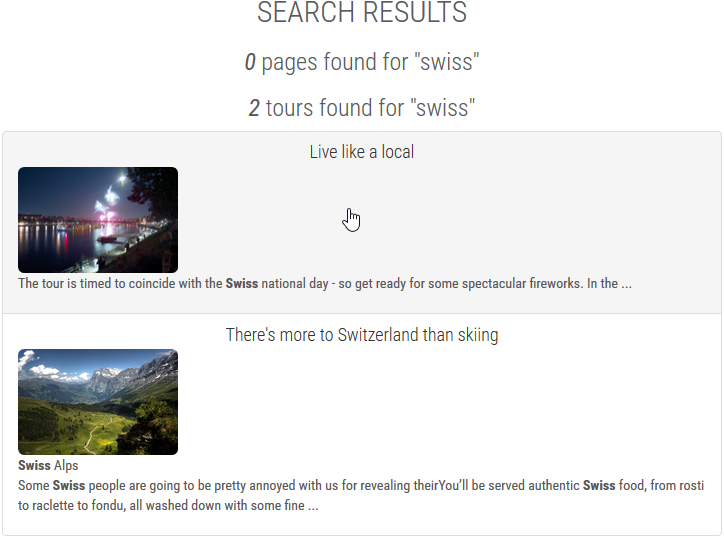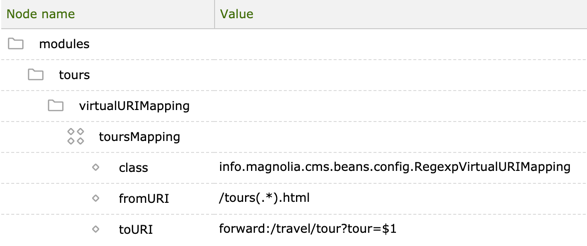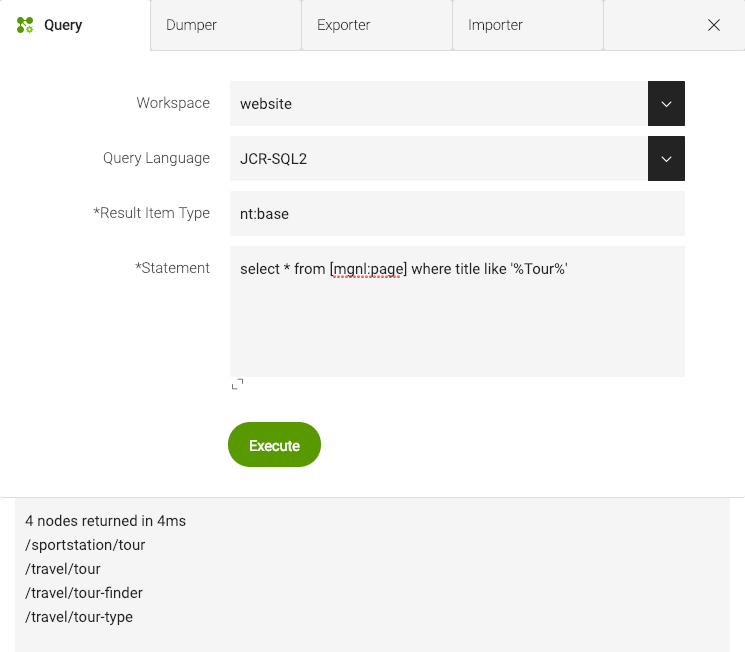Jackrabbit search
By default Magnolia’s search functionality is provided by the Jackrabbit repository and this page describes the configuration options for Jackrabbit-based search. For more advanced search options and especially if you need to manage high volumes of assets you can set up Magnolia to use Apache Solr, see Solr search.
How search indexing works
A workspace needs to be indexed in order to make information retrieval fast and accurate. Indexing is the process of collecting and parsing content, and storing the data in an index to make it easier and faster to retrieve requested portions of the data.
Magnolia search is based on the default Jackrabbit search implementation. Jackrabbit uses an Apache Lucene-based indexer to process the data stored in the JCR. Node names and property values are indexed immediately and stored in the repository. Text from documents is extracted in a background process which makes document content searchable after a short delay.
Each Magnolia instance has its own repository and its own index. This means that the author instance index is typically different from public instance indexes. Any content that has not been published to a public instance cannot be found when running a search on that public instance.
Magnolia index configuration
Magnolia uses a custom Jackrabbit/Lucene indexing configuration.
The indexing configuration file is in the Magnolia Core module in /src/main/resources/info/magnolia/jackrabbit and org.apache.jackrabbit.core.query.lucene.SearchIndex gets it from the classpath.
The generic indexing configuration used for all workspaces except the website workspace is stored in /info/magnolia/jackrabbit/indexing_configuration_default.xml.
The indexing configuration for the website workspace is in /info/magnolia/jackrabbit/indexing_configuration_website.xml.
You can configure indexing for additional workspaces by setting the workspace name in <param name="indexingConfiguration" value="/info/magnolia/jackrabbit/indexing_configuration_${wsp.name}.xml"/> in the workspace.xml configuration file.
These configurations fine-tune the default Jackrabbit search configuration for best results. The sections that follow detail the enhancements. See also Search index configuration file for more information.
|
Special characters Jackrabbit stores all character data (node names and values) in Unicode. This ensures that special characters such as accents and umlauts are indexed and can be used in search. Issues with special characters are often due to character set conversion problems in the application server. |
Website indexing configuration file
The website indexing and generic indexing configuration files are configured in the Magnolia Core module in /src/main/resources/info/magnolia/jackrabbit.
Since Magnolia CMS 6.2.55, the website indexing configuration has been improved to include new entries for contentNodes.
These additions make them searchable in the Find bar and in-app search forms.
If you want to add this configuration yourself to an earlier Magnolia version, you can add the highlighted new entries in the configuration example below.
<configuration xmlns:nt="http://www.jcp.org/jcr/nt/1.0" xmlns:mgnl="https://www.magnolia-cms.com/jcr/mgnl" xmlns:jcr="http://www.jcp.org/jcr/1.0">
<index-rule nodeType="nt:base">
<!-- unlike other system properties, we want mgnl:tags to be indexed -->
<property>mgnl:tags</property>
<property isRegexp="true" nodeScopeIndex="false">mgnl:.*</property>
<property isRegexp="true" nodeScopeIndex="false">jcr:.*</property>
<!-- notice how the catch-all property should come at the end after all specific ones -->
<property isRegexp="true">.*:.*</property>
</index-rule>
<index-rule nodeType="mgnl:page">
<property boost="3.0">title</property>
<canSkipProperty>mgnl:activationStatus</canSkipProperty> (1)
<canSkipProperty>mgnl:lastActivated</canSkipProperty> (1)
<canSkipProperty>mgnl:lastActivatedBy</canSkipProperty> (1)
<canSkipProperty>mgnl:lastActivatedVersion</canSkipProperty> (1)
<canSkipProperty>mgnl:lastActivatedVersionCreated</canSkipProperty> (1)
</index-rule>
<index-rule nodeType="mgnl:area">
<excludeProperty>mgnl:activationStatus</excludeProperty> (2)
<excludeProperty>mgnl:lastActivated</excludeProperty> (2)
<excludeProperty>mgnl:lastActivatedBy</excludeProperty> (2)
</index-rule>
<index-rule nodeType="mgnl:component">
<excludeProperty>mgnl:activationStatus</excludeProperty> (2)
<excludeProperty>mgnl:lastActivated</excludeProperty> (2)
<excludeProperty>mgnl:lastActivatedBy</excludeProperty> (2)
</index-rule>
<index-rule nodeType="mgnl:contentNode">
<excludeProperty>mgnl:activationStatus</excludeProperty> (3)
<excludeProperty>mgnl:lastActivated</excludeProperty> (3)
<excludeProperty>mgnl:lastActivatedBy</excludeProperty> (3)
</index-rule>
<aggregate primaryType="mgnl:page">
<include primaryType="mgnl:area">*</include>
<include primaryType="mgnl:component">*</include>
<include primaryType="mgnl:contentNode">*</include> (4)
</aggregate>
<aggregate primaryType="mgnl:area" recursive="true">
<include primaryType="mgnl:component">*</include>
<include primaryType="mgnl:area">*</include> (5)
<include primaryType="mgnl:contentNode">*</include> (4)
</aggregate>
<aggregate primaryType="mgnl:component" recursive="true">
<include primaryType="mgnl:area">*</include>
<include primaryType="mgnl:component">*</include> (5)
<include primaryType="mgnl:contentNode">*</include> (4)
</aggregate>
<aggregate primaryType="mgnl:contentNode" recursive="true">
<include primaryType="mgnl:contentNode">*</include> (4) (5)
</aggregate>
</configuration>| 1 | Indexing of these properties is bypassed only when the publishing metadata is updated. |
| 2 | Excludes specific properties from indexing.
Explicitly defined for mgnl:area and mgnl:component because the excludeProperty doesn’t support inheritance or regular expressions, requiring separate index rules for each node type. |
| 3 | Excludes specific properties from indexing for mgnl:contentNode to optimize search performance by omitting irrelevant metadata. |
| 4 | New entries required to make content nodes searchable. |
| 5 | Areas, components, contentNodes can be nested. See Configuration files for details on recursion and nested areas. |
| When you add aggregates, it can increase your index size when indexing and reindexing. |
The location of the website’s indexing configuration file, workspace.xml, is configured in the instance property magnolia.repositories.home.
...
<SearchIndex class="info.magnolia.jackrabbit.lucene.SearchIndex">
<param name="path" value="${wsp.home}/index"/>
<param name="indexingConfiguration" value="/info/magnolia/jackrabbit/indexing_configuration_${wsp.name}.xml"/> (1)
...| 1 | The SearchIndex takes the indexing configuration from the classpath if it isn’t found in the workspace home. |
Excluding nodes
Magnolia typically stores many properties, such as author, modification dates, templates etc., that are not relevant in search results.
To minimize the index and speed-up search, all properties starting with jcr: or mgnl: are excluded from the index.
This means you get fewer results but those results are more relevant.
<index-rule nodeType="nt:base">
<property isRegexp="true" nodeScopeIndex="false">mgnl:.*</property>
<property isRegexp="true" nodeScopeIndex="false">jcr:.*</property>
<property isRegexp="true">.*:.*</property>
</index-rule>Skipping properties
|
This is an experimental feature.
It’s disabled by default and must be enabled in the You can also set it at the JVM level using the Be aware that setting it via the |
To optimize indexing and search performance, you can use the canSkipProperty and excludeProperty rules to exclude specific properties from an indexing task.
The canSkipProperty rule skips indexing only when publishing metadata is updated, while the excludeProperty rule unconditionally blocks indexing.
In the example below, the listed properties are excluded when indexing nodes of type mgnl:contentNode.
...
<index-rule nodeType="mgnl:contentNode">
<excludeProperty>mgnl:activationStatus</excludeProperty>
<excludeProperty>mgnl:lastActivated</excludeProperty>
<excludeProperty>mgnl:lastActivatedBy</excludeProperty>
</index-rule>
...|
The rules require info.magnolia.jackrabbit.lucene.MagnoliaIndexingConfiguration to be set in the basic workspace configuration via the The rules don’t support inheritance or regular expressions. |
Boosting the title property
By default, indexing configuration boosts the title property of the mgnl:page node type since page titles are important.
<index-rule nodeType="mgnl:page">
<property boost="3.0">title</property>
</index-rule>Including areas and components
The configuration uses index aggregates to ensure area and component content is included in the index.
The properties of mgnl:area and mgnl:component make up most of page content and need to be included explicitly.
The aggregate also simplifies searching for content within pages.
Nested areas are also included using the recursive flag.
<aggregate primaryType="mgnl:page">
<include primaryType="mgnl:area">*</include>
<include primaryType="mgnl:component">*</include>
</aggregate>
<!-- areas can be nested. See http://wiki.apache.org/jackrabbit/IndexingConfiguration for recursion -->
<aggregate primaryType="mgnl:area" recursive="true">
<include primaryType="mgnl:component">*</include>
<include primaryType="mgnl:area">*</include>
</aggregate>Providing excerpts and highlighting search results
The workspace.xml file in each workspace enables highlighting in search results and the Jackrabbit HTML excerpt provider class.
The workspace.xml files are in /<CATALINA_HOME>/webapps/<contextPath>/repositories/magnolia/workspaces/<workspace name>.
Here’s the relevant extract from workspace.xml in the contacts workspace.
<!-- needed to highlight the searched term -->
<param name="supportHighlighting" value="true"/>
<!-- custom provider for getting an HTML excerpt in a query result with rep:excerpt() -->
<param name="excerptProviderClass" value="info.magnolia.jackrabbit.lucene.SearchHTMLExcerpt"/>|
If you have configured your own app that operates on its own workspace and provides content for the website, you need to add these parameters to the |
|
If you have used fields which allow for the storing of HTML, then that HTML will be indexed along with content. There is potential for the excerpt to contain HTML tags which are not closed. |
Implementing search using templating functions
Templating functions are used to render search results on a site without the need for a component model or Java knowledge. Although they are not directly related to the indexing process, you can use them to display the search results retrieved from the index.
There are many ways to implement search on a site.
This section explains how to do it using templating functions and uses the Magnolia Travel Demo site as an example.
If the demo modules are not installed your can download the magnolia-travel-demo-parent module and install the demo and tours modules.
The MTE module provides search templating functions that allow front-end developers to render search results using only a template script.
Template function methods
There are methods for searching pages and other content, such as content stored in content apps.
The methods are exposed in templates as searchfn and you can find templating examples at searchfn.
All you need to implement search on a site is a component to retrieve the results from the search index and display them on the page.
This is how search works on the Magnolia Travel Demo site.
-
searchResultscomponent searches pages and content apps for relevant results andsearchResults.ftlrenders this component. -
searchResultsPagetemplate autogenerates thesearchResultscomponent. -
Search results display on the
/travel/meta/search-resultspage that is based on thesearchResultsPagetemplate. -
/search-resultspage is assigned as the search page for the site in thehomePagePropertiesdialog.
| See the travel-demo repository for specific examples. |
Displaying pages in the website workspace
The searchPages method displays pages stored in the website workspace in the search results.
This method retrieves pages whose content (text, image and other properties) was added manually in the Pages app, as opposed to content retrieved from an app or another source. Set the root path of the site to return the relevant items.
Here’s the snippet from searchResults.ftl in the Travel Demo.
The root path is /travel.
[#-------------- ASSIGNMENTS --------------]
[#assign queryStr = ctx.getParameter('queryStr')!?html]
[#-------------- RENDERING --------------]
[#if content.headline?has_content]
<h2>${content.headline}</h2>
[/#if]
[#if queryStr?has_content]
[#assign searchResults = searchfn.searchPages(queryStr, '/travel') /]
[#assign recordsFound = searchResults?size /]
<h3><em>${recordsFound}</em> ${i18n['search.pagesFoundFor']} "${queryStr}"</span></h3>
<div class="list-group">
[#if searchResults?has_content]
[#list searchResults as item]
<a href="${cmsfn.link(item)}" class="list-group-item">
<h4 class="list-group-item-heading">${item.title!}</h4>
<p class="list-group-item-text">${item.excerpt!}</p>
</a>
[/#list]
[/#if]
</div>
<#-- More processing here, not shown in snippet >
[/#if]Here are the results for the term contact.
Excerpts and highlighting are provided automatically by the indexing configuration.

Displaying content stored in apps
The searchContent method allows you to search any content in the JCR.
The method is useful to display pages whose content is stored in another workspace.
In this scenario, you need to set the workspace where the content is stored, the parent URL within that workspace and the node type.
In the Magnolia Travel Demo site, all Tour content (text, images and more) is entered in the Tours app and retrieved by a component that displays the content on pages.
The app content is stored in the tours workspace, under /magnolia-travels and is of node type mgnl:content.
Here’s the snippet from searchResults.ftl that retrieves Tours app content.
[#assign searchResults = searchfn.searchContent('tours', queryStr, '/magnolia-travels', 'mgnl:content') /]
[#assign recordsFound = searchResults?size /]
<h3><em>${recordsFound}</em> ${i18n['search.toursFoundFor']} "${queryStr}"</span></h3>
<div class="list-group">
[#if searchResults?has_content]
[#list searchResults as item]
<a href="${cmsfn.link(item)}" class="list-group-item">
<h4 class="list-group-item-heading">${item.description!}</h4>
<img src="${damfn.getAssetLink(item.image)}" class="img-responsive img-rounded" height="80" width="160" alt="${item.description!}"/>
<p class="list-group-item-text">${item.excerpt!}</p>
</a>
[/#list]
[/#if]
</div>Here are the results for the term swiss.

URI mappings
You can use URI mappings to redirect incoming requests to the location of content, ensuring that the content is included in the search index. This means that URI mappings play a role in determining which content is indexed and how it is indexed in the search configuration.
|
When you display results from content app workspaces, build a link to a detail page that displays the content item in question using URI mappings. URI mapping is used in the Demo Travels example to display app content on pages and ensure that the content is included in the search index. |
Configuring URI2Repository mapping
The URI2Repository mapping URI mapping mechanism determines which repository node should be served when a particular URI is requested.
Here’s the URI2Repository mapping for the tours workspace in /server/URI2RepositoryMapping/mappings/tours.
| Node name | Value |
|---|---|
⸬ tours |
|
⬩ repository |
tours |
⬩ handlePrefix |
|
⬩ URIPrefix |
/tours/ |
| Property | Description |
|---|---|
|
|
|
Injects the |
|
Repository the mapping applies to. |
Configuring VirtualURI mapping
Virtual URI mapping allows you to create short, convenient URLs.
Here’s the virtual URI mapping for the Tours app:

| Property | Description | ||
|---|---|---|---|
|
Tours virtual URI mapping node.
|
||
|
|
||
|
Path to tours in the tours workspace as mapped in the |
||
|
URI to which tours are forwarded |
Customizing search
You can customize search by writing your own queries to search the index and execute them in code. A query returns a result set which you can display on a page.
You can test your queries in the Query subapp. When you get the result set you want, implement the query in code.

Example queries
The following queries are written in SQL-2. See JCR Query Cheat Sheet for more examples.
-
Find pages that contain the word
swiss.Workspace:
websiteSELECT * FROM [mgnl:page] AS t WHERE ISDESCENDANTNODE([/tours]) AND CONTAINS(t.*, 'swiss')
-
Find modules that have commands. This query looks for a folder named
commandsin the module configuration.Workspace:
configSELECT * FROM [mgnl:content] AS t WHERE ISDESCENDANTNODE([/modules]) AND name(t) = 'commands'
-
Find assets that are not JPG images under the
/examplepath in the DAM.Workspace:
damSELECT * FROM [nt:base] AS t WHERE ([jcr:primaryType] = 'mgnl:asset' AND [type] <> 'jpg') AND ISDESCENDANTNODE([/example]) ORDER BY [t].title asc
Security
Search within Magnolia is access controlled. Search results include only content the user has permission to access. Permissions are controlled through Security. When you execute a query in info.magnolia.context.MgnlContext, contextual factors such as the current user’s permissions are taken into account. If you do not have permission to the items you are querying, they will not show up in the results.